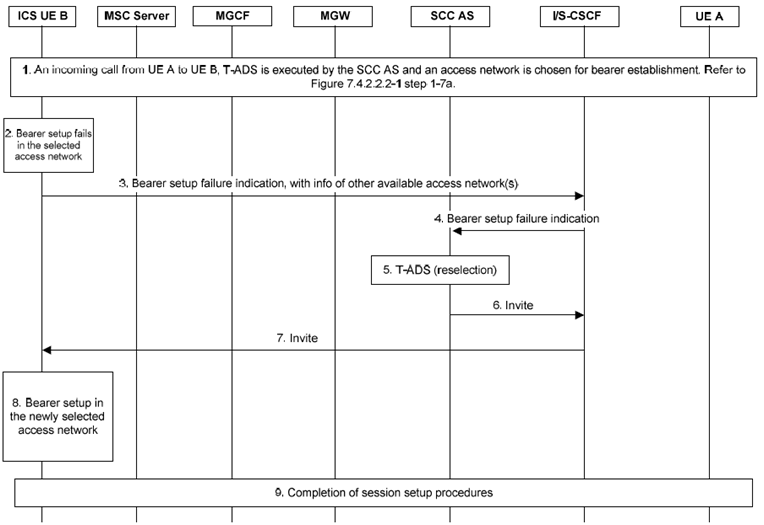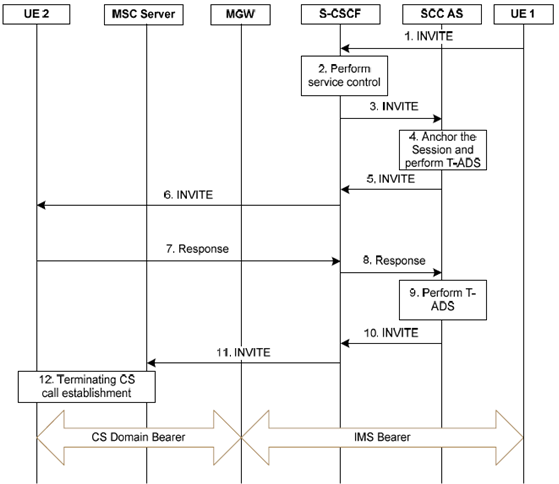Content for TS 23.292 Word version: 18.0.0
1…
4…
5…
7…
7.2…
7.3…
7.3.2.2…
7.3.2.2.4…
7.4…
7.4.2.2…
7.4.2.2.3…
7.4.2.2.7…
7.5…
7.6…
7.6.1.2.2.6…
7.6.1.2.3…
7.6.1.2.3.5…
7.6.1.2.3.6…
7.6.2…
7.6.2.7
7.6.2.8…
7.6.2.11…
7.6.3…
7.7…
7.7.2…
7.9…
7.9.2…
7.9.2.4
7.9.2.5
8…
A…
G…
H…
H.5…
H.5.3…
7.4.2.2.7 Terminating access network reselection - fallback to alternate access
7.4.3 Terminating sessions over Gm rejected by the UE
...
...
7.4.2.2.7 Terminating access network reselection - fallback to alternate access |R9| p. 56
When using the Gm reference point for delivery of the incoming session to the ICS UE, if it fails to set up the bearer in the selected terminating access network and other access network(s) is available for the service, the UE may send a message to the SCC AS indicating the failure of bear setup with the information required for access network reselection (e.g. the information of available access network(s)), or indicate a newly selected access network. The SCC AS can then, based on the message and operator policy, update the relevant decision information for T-ADS if necessary and reselect a new access network for bearer setup to complete the terminating session establishment.
Figure 7.4.2.2.7-1 gives an example flow of terminating access reselection for ICS UE terminating session establishment using Gm reference point.

Figure 7.4.2.2.7-1: Access reselection for ICS UE termination over Gm reference point
(⇒ copy of original 3GPP image)
(⇒ copy of original 3GPP image)
Step 1.
An incoming call arrives at UE B from UE A. T-ADS is executed by the SCC AS and an access network is chosen for bearer establishment (refer to Steps 1-7a in Figure 7.4.2.2.2-1).
Step 2.
Bearer setup fails in the selected access network.
Step 3.
UE B sends a message to the I/S-CSCF indicating the failure of bearer setup. Information required for the SCC AS to re-execute T-ADS and to select a new access network is provided (e.g. info of access network(s) available for the service), or a new access network selected by the UE for bearer setup is indicated.
Step 4.
The I/S-CSCF forwards the message to the SCC AS based on originating initial filter criteria.
Step 5.
The SCC AS updates the relevant decision information for T-ADS and re-executes T-ADS to select a new access network for bearer setup of the session if no new access network is selected by the UE.
Step 6-7.
The SCC AS sends an Invite message to UE B via the S-CSCF to establish the session, with the newly selected access network for bearer setup indicated or confirmed (if selected by the UE).
Step 8.
Bearer setup in the newly selected terminating access network for the session.
Step 9.
Completion of session setup procedures between UE A and UE B.
7.4.3 Terminating sessions over Gm rejected by the UE p. 57
Figure 7.4.3-1 provides an example flow for a call destined to a UE-2 and where the incoming session is delivered over the Gm reference point offering either PS speech media, CS media, or PS speech media with alternative CS media, because the SCC AS is unable to accurately determine that the CS domain should be used, e.g. when ISR according to TS 23.401 is active and if the UE hasn't re-registered in the IMS. In this example call flow the UE-2 rejects the incoming session and T-ADS in the SCC AS selects CS domain for termination. The flow applies to both ICS UE and non ICS UE.

Step 1.
The request is received at S-CSCF following normal IMS session set up procedures.
Step 2~3.
The service logic with iFC causes the request to be forwarded to the SCC AS.
Step 4.
The SCC AS anchors the session. T-ADS is executed and the PS access is selected for termination.
Step 5~6.
The SIP INVITE is forwarded to the UE via the selected PS access. Paging is triggered if the UE is in Idle state.
Step 7~8.
The UE determines that PS access cannot be used for a session with the offered media and it returns a response to the IMS indicating the error condition. The S-CSCF forwards the message to the SCC AS.
Step 9.
On receiving the response, the SCC AS reattempts the terminating call establishment directly towards the same UE over CS domain if possible.
Step 10~11.
The SIP INVITE is forwarded to UE-2 via the MSC Server enhanced for ICS (or via MGCF and MSC if the MSC is not enhanced for ICS).
Step 12.
Terminating CS call establishment.